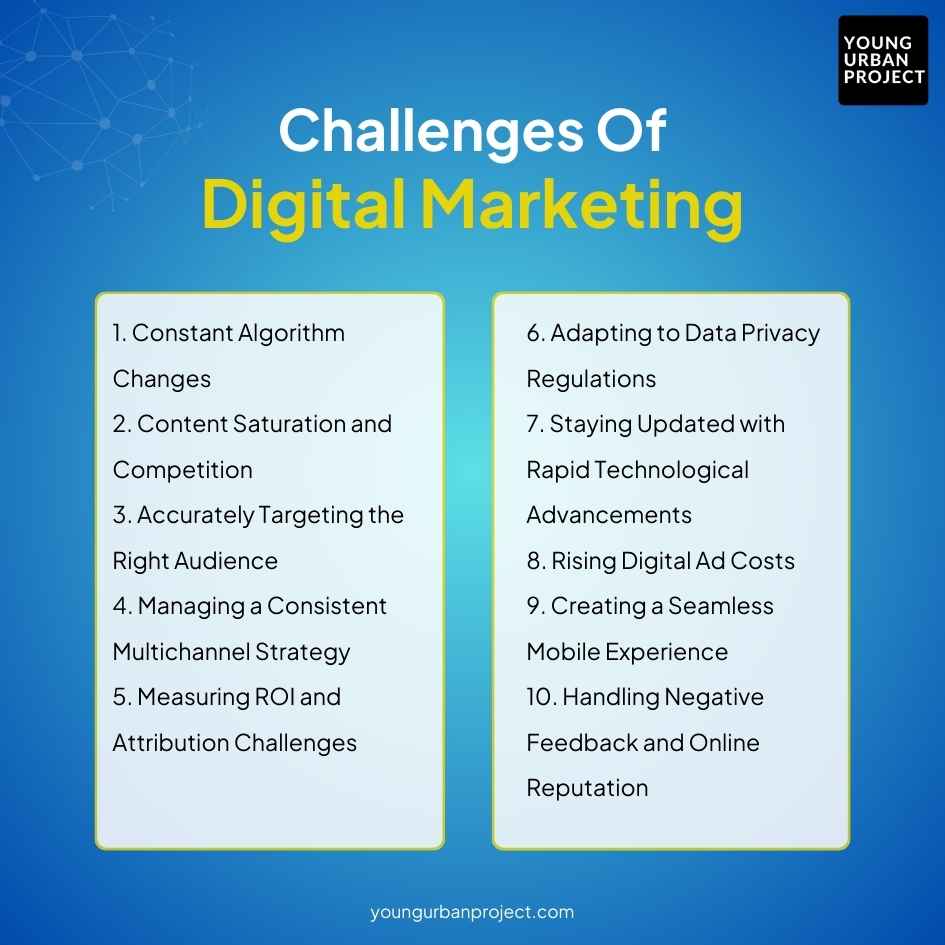So, you put hours into creating the perfect digital marketing strategy. You’ve followed the latest trends, executed a well-planned campaign, and invested in the right tools. But despite all your efforts, you’re still not getting the results you anticipated. This is how complex digital marketing can be. The constant evolution and fierce competition can make even the most experienced marketers stumble in this field.
The truth is that the challenges of digital marketing can be overwhelming at times. Whether it’s staying ahead of algorithm updates, keeping up with technological trends, or proving ROI, digital marketers face a unique set of hurdles. However, these obstacles also present opportunities for growth. With the right approach, each challenge can be transformed into a chance to innovate, adapt, and succeed.
Let’s see the major challenges of digital marketing and explore the strategies you can use to tackle them.
Challenges of Digital Marketing

1. Constant Algorithm Changes
A marketer’s nightmare one day, your content is ranking high on Google or gaining traction on Instagram, and the next, it seems to have vanished into the digital abyss. The culprit? Algorithm changes. Google, Facebook, and other platforms frequently update their algorithms, leaving marketers scrambling to understand how to maintain visibility.
Solution: Continuous Learning and Real-Time Adaptation
The key to overcoming algorithm changes is to stay informed and flexible. Follow industry blogs, forums, and influencers who track and explain algorithm updates. Some great resources include Google Search Central, and Moz blogs. You should also adopt an agile marketing strategy, running A/B tests and monitoring performance in real-time. This helps you quickly adapt to changes, rather than being caught off-guard.
For example, when Google’s BERT update prioritized content based on user intent, savvy marketers shifted from keyword stuffing to creating content that answered specific queries. By aligning your strategy with the algorithm’s goals, you can stay ahead of the game.
2. Content Saturation and Competition
With millions of pieces of content being published online daily, cutting through the noise has become one of the top challenges of digital marketing. As more businesses embrace digital marketing, the competition for user attention has skyrocketed, leaving marketers wondering how to make their content stand out.
Solution: Prioritize Unique, High-Quality Content
Your content must be unique and valuable to rise above the noise. Focus on understanding your audience’s pain points and create content that directly addresses those issues in a way your competitors haven’t. For example, while generic “SEO tips” articles are everywhere, providing in-depth guides tailored to niche industries (e.g., “SEO for e-commerce in 2024”) will stand out.
Additionally, diversify your content formats. Video, interactive quizzes, infographics, and podcasts can capture attention more effectively than traditional blog posts. And always prioritize quality over quantity—publishing one well-researched, impactful piece can be far more effective than churning out five mediocre ones.
3. Accurately Targeting the Right Audience
Reaching the right audience is one of the foundational challenges of digital marketing. With the vast number of users online, it’s easy to get your message in front of the wrong people, resulting in wasted ad spend and poor engagement.
Solution: Leverage Advanced Segmentation and Personalization
Start by clearly defining your buyer personas—understanding their demographics, interests, and pain points. Use tools like Google Analytics and Facebook Audience Insights to gather data about your current customers, then segment your audience based on behaviors, geography, or other relevant factors.
Personalization is the next step. Today’s consumers expect tailored experiences, and businesses that fail to deliver miss out. Personalized email campaigns, dynamic ads that adjust to user behavior, and personalized product recommendations can help you connect with the right audience more effectively. For example, Amazon’s recommendation engine drives a significant portion of its revenue by showing users products that match their browsing and purchasing habits.
Also read: Advantages of Digital Marketing: Its Benefits In 2024
4. Managing a Consistent Multichannel Strategy
In today’s digital landscape, consumers interact with brands across multiple touchpoints—social media, search engines, email, and more. However, one of the most difficult challenges of digital marketing is ensuring consistency across all these channels while maintaining an effective strategy.
Solution: Adopt an Integrated Marketing Approach
A unified multichannel approach is essential. Start by creating a core brand message that stays consistent across all platforms. Whether a customer encounters your brand on Facebook, through a Google search, or via an email campaign, the tone, style, and messaging should be cohesive.
Use tools like Hootsuite or HubSpot to manage and schedule content across multiple platforms, ensuring that timing and tone align. Regularly reviewing data from each channel will help you identify what’s working where and adjust your strategy accordingly. An integrated marketing approach allows you to engage your audience wherever they are, while creating a seamless brand experience.
Also Read: Performance Marketing Online Training
5. Measuring ROI and Attribution Challenges
How do you know if your digital marketing efforts are paying off? Measuring the return on investment (ROI) for digital campaigns can be tricky, especially when there are multiple touchpoints along the customer journey. Additionally, attributing the right success metrics to the right channels is one of the top challenges of digital marketing.
Solution: Use Multi-Touch Attribution and Clear KPIs
A multi-touch attribution model is essential for understanding the impact of each channel. Instead of giving all the credit to the last touchpoint, multi-touch models distribute credit across the entire journey, helping you see how various channels contribute to a conversion.
Using tools like Google Analytics or HubSpot’s attribution models will give you a better view of your marketing’s effectiveness. In addition, define clear KPIs that align with your business goals. Whether it’s lead generation, sales, or brand awareness, understanding which metrics matter most will make it easier to measure success and optimize future efforts.

6. Adapting to Data Privacy Regulations
With increasing scrutiny around data privacy, marketers need to navigate regulations like the General Data Protection Regulation (GDPR) in Europe or the California Consumer Privacy Act (CCPA). Balancing personalized marketing with privacy compliance is one of the more pressing challenges of digital marketing today.
Solution: Transparency and Ethical Data Usage
First and foremost, prioritize transparency in how you collect and use data. Inform users about the data you’re gathering and why, and ensure they can opt out if they choose. Use clear consent forms and avoid hidden or deceptive practices.
In terms of marketing, focus on first-party data (information collected directly from your audience). Use surveys, email subscriptions, and in-app activities to gather data in a compliant way. Ethical data usage not only builds trust but also helps you create more effective, personalized marketing campaigns.
7. Staying Updated with Rapid Technological Advancements
From AI-driven marketing tools to voice search, the landscape of digital marketing is constantly evolving. Marketers are often faced with the dilemma of adopting new technologies while ensuring they don’t fall behind their competitors.
Solution: New Technologies with Scalable Tools
To keep up with technological advancements, prioritize tools that are scalable and can easily integrate new features. Marketing automation platforms like Marketo or HubSpot allow you to scale your efforts, incorporating AI-driven personalization or chatbots without overhauling your entire system.
Additionally, invest in training your team. Stay updated on emerging trends by attending webinars, reading industry reports, and subscribing to newsletters from thought leaders. Being early adopters of relevant technologies can give you a competitive advantage and increase the efficiency of your digital marketing efforts.
8. Rising Digital Ad Costs
The cost of running paid ad campaigns on platforms like Google, Facebook, and Instagram has been steadily rising, making it one of the most common challenges of digital marketing. Small businesses, in particular, struggle to compete with larger players who can afford to dominate paid ad spaces.
Also Read: Voice Search Optimization
Solution: Focus on High-ROI Channels and Organic Growth
To navigate rising ad costs, it’s essential to prioritize the channels that offer the best return on investment (ROI). Use detailed analytics to assess which platforms are delivering the most value, then adjust your spending accordingly. For instance, if your Google Ads are driving conversions at a lower cost than Facebook Ads, allocate a larger portion of your budget to Google.
Organic growth should also be a key focus. Invest in long-term strategies like SEO and content marketing to build sustainable traffic without the ongoing costs associated with paid ads.
9. Creating a Seamless Mobile Experience
With more than half of all internet traffic coming from mobile devices, optimizing for mobile has become a non-negotiable. Yet, many businesses still struggle to deliver a seamless mobile experience, leading to high bounce rates and missed conversions.
Solution: Prioritize Mobile Optimization and Responsive Design
Mobile optimization should be at the core of your digital strategy. Ensure that your website is fully responsive, meaning it adapts to any screen size, whether on a phone, tablet, or desktop. Speed is also critical—Google’s mobile-first indexing prioritizes websites that load quickly on mobile devices.
Focus on optimizing for mobile search, voice search, and localized content, as mobile users often search with location-based intent. Simple tweaks like reducing image sizes, using mobile-friendly layouts, and adding click-to-call buttons can drastically improve your mobile performance.
10. Handling Negative Feedback and Online Reputation
In the era of social media, managing your online reputation is a significant challenge. Negative feedback, if not handled properly, can damage your brand’s image and deter potential customers.
Solution: Respond Proactively and Build a Positive Presence
Respond promptly and professionally when faced with negative reviews or feedback. Show empathy and a willingness to resolve issues, turning a negative experience into a positive one. Tools like Google Alerts or Reputation.com can help you monitor mentions of your brand across the web.
At the same time, build a strong positive online presence by encouraging satisfied customers to leave reviews. Showcase positive testimonials and case studies on your website and social media to counterbalance any negative feedback.
Conclusion
While digital marketing comes with its fair share of challenges, it also offers limitless opportunities for those who are willing to adapt, learn, and innovate. By understanding the obstacles and implementing strategies to overcome them, you can transform these challenges into stepping stones for success. Stay informed, embrace change, and keep refining your approach to achieve the best possible outcomes in your digital marketing efforts.
FAQs: Challenges of Digital Marketing
What are the biggest challenges of digital marketing today?
The biggest challenges of digital marketing today include constant algorithm changes, content saturation, rising competition, measuring ROI, data privacy regulations, and staying updated with rapid technological advancements. Other challenges include targeting the right audience, managing multichannel strategies, rising digital ad costs, and handling negative feedback.
How do algorithm changes affect digital marketing strategies?
Algorithm changes can drastically affect digital marketing strategies by altering how content is ranked and displayed. For example, Google’s search algorithm updates may change how websites rank in search results, while changes to social media algorithms can reduce the visibility of organic posts. Marketers must continuously monitor and adapt to these changes to maintain visibility and engagement.
How can businesses overcome the challenge of rising digital ad costs?
Businesses can overcome rising digital ad costs by focusing on high-ROI channels, optimizing their ad campaigns, and prioritizing organic growth through SEO and content marketing. Additionally, running A/B tests, targeting more specific audience segments, and utilizing remarketing strategies can help businesses get better returns on their ad spend.
How do data privacy regulations impact digital marketing?
Data privacy regulations like the GDPR (General Data Protection Regulation) and CCPA (California Consumer Privacy Act) impact digital marketing by restricting how businesses can collect, store, and use customer data. To remain compliant with these laws, marketers need to be transparent about their data practices, obtain user consent, and focus on ethical data collection.
What is the importance of multichannel marketing in digital strategy?
Multichannel marketing is important because it allows businesses to reach their target audience across various platforms and touchpoints, such as social media, email, websites, and paid ads. Consistency across these channels helps create a seamless brand experience for the customer, increasing the chances of conversion and engagement.
How can I improve targeting in digital marketing?
Improving targeting in digital marketing involves creating detailed buyer personas, using tools like Google Analytics to understand your audience’s behavior, and leveraging advanced segmentation options in platforms like Facebook Ads or Google Ads. Personalization through dynamic content and retargeting campaigns can also help ensure you reach the right audience with the right message.
What is the best way to measure ROI in digital marketing
The best way to measure ROI in digital marketing is to set clear goals and KPIs (Key Performance Indicators) from the start and use tools like Google Analytics, HubSpot, or specialized attribution tools to track performance. Multi-touch attribution models can also help assign value to each channel in the customer journey, making it easier to see which efforts are delivering results.
Why is content saturation a problem in digital marketing?
Content saturation is a problem because there’s an overwhelming amount of information available online, making it difficult for businesses to capture and hold their audience’s attention. With so much content competing for visibility, marketers need to produce high-quality, unique, and valuable content to stand out and engage their target audience.
How can I optimize my digital marketing for mobile users?
To optimize for mobile users, you should ensure your website is mobile-responsive, has fast load times, and is easy to navigate on small screens. Focus on mobile SEO, voice search optimization, and creating content that is easily consumable on mobile devices, such as short videos, infographics, and mobile-friendly layouts.
What are the risks of not managing online reputation effectively?
Failing to manage your online reputation can result in negative reviews, feedback, or misinformation spreading unchecked, harming your brand’s credibility and deterring potential customers. Proactively monitoring your online presence, responding quickly to negative feedback, and encouraging satisfied customers to leave positive reviews are essential steps in maintaining a strong online reputation.

